9 Jul 2019

It is not hard to believe rabbits are one of Britain’s most popular pets; however, sadly their welfare needs have not been adjusted accordingly over the years.
It is important that, as veterinary professionals, we are giving up-to-date information to existing rabbit owners and potential new ones. This may include informing owners about housing, nutrition, health checks and vaccinations, neutering and insurance. This article will discuss these topics.
Rabbits have been traditionally kept in hutches, but many now live alongside their owners and other family pets as house rabbits. Those living outside are often housed in large sheds or specially adapted hutches with exercise areas attached.
The Rabbit Welfare Association and Fund (RWAF) has an ongoing campaign called “A Hutch Is Not Enough”, which aims to raise awareness of hutch size and outdoor accommodation (RWAF, 2019). It also gives information to suppliers of hutches on the recommended dimensions realistically suitable for a pet rabbit.
The hutch should be 6ft long to enable the rabbit to hop and stretch, and 2ft high so it can reach up on its hindlegs. These are just a guideline – depending on the size and number of rabbits being kept, the space may need to be much bigger.
It is vital all rabbits have access to a secure area where they can exercise – this may be a fenced-in run area or free-ranging, depending on the garden security and risk from predators. A run should be a minimum of 2ft high and 6 sq ft to 8 sq ft (Figure 1).
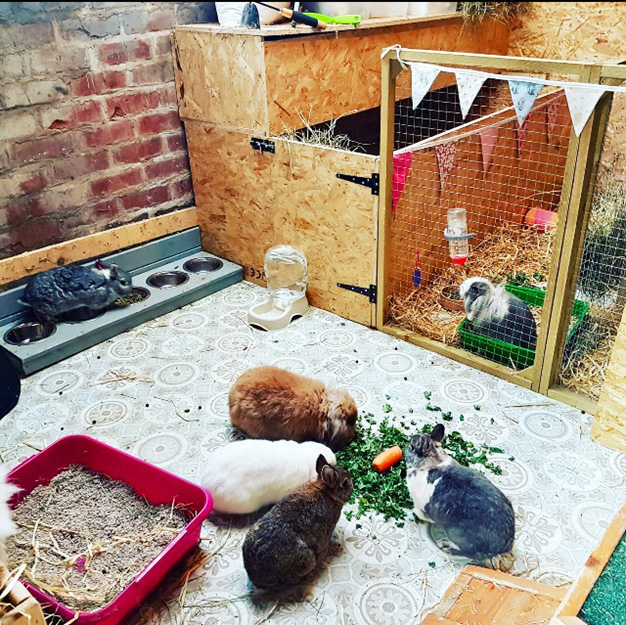
Exercise is very important to rabbits’ welfare as they are naturally very active animals. They enjoy jumping, hopping, running and digging, and should have the opportunity to exhibit this normal natural behaviour every day. Exercise also helps build muscle and creates good body tone. Being kept in a cage all day is unstimulating and depressing for any animal. Without sufficient exercise, rabbits can become quickly bored and obese, leading to a variety of other health issues.
Good environmental enrichment can help promote exercise and mental activities. Foraging is an important part of a rabbit’s natural behaviour, so food can be hidden in toys, boxes and cardboard tubes, and hay provided in hay racks. They can also be provided with trays of soil to provide instinctive digging behaviour. As rabbits naturally need to chew and grind their teeth due to the continuous growth, they can be provided with things to safely chew, too; this can be cardboard boxes, tubes or specially designed rabbit toys. Branches from fruit trees can also be used (Figure 2).
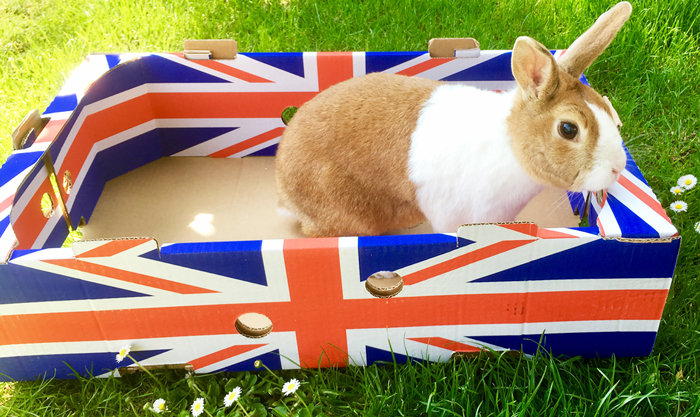
The rabbit’s environment should also include hiding places, as prey species need somewhere to bolt and feel secure. A separate toileting area should also be provided – litter trays can be used. Shallow trays are better, as they do not tip as easily when a rabbit hops in and out. Rabbit-friendly litter or shredded newspaper can be used.
Indoor rabbits should have a safe area, such as an indoor cage or hutch, where they can be safely placed at night or while unattended. This is mainly for their own protection in case they chew through electric cables, house plants, or gain access to other toxic substances such as cleaning products and plug-in air fresheners.
They may also need protecting from other animals in the house, such as cats and dogs. No matter how friendly these interactions between species may appear, it is very important to remember that an animal’s instincts can often be unpredictable.
Companionship is important to rabbits because they are a social species and naturally live in large wild colonies, so enjoy the company and social interaction of another rabbit to live with. They should be kept in pairs or small groups, and neutering is recommended to prevent unwanted litters and fighting due to territorial behaviour.
Interaction with humans can also be enjoyed by rabbits very much – especially when they are gradually habituated to the interaction and handling is started at an early age. However, this should not replace the company of another rabbit (Figure 3).
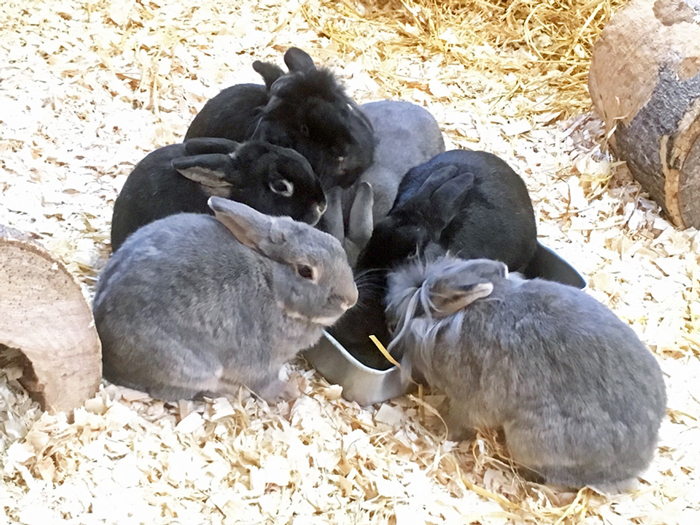
It is essential rabbits receive the correct nutrition – not doing so can lead to a number of different health issues, including obesity, poor dentition, dysbiosis and digestive dysfunction causing gut hypomotility, which can be fatal in rabbits if not treated quickly.
Rabbits are herbivores, allowing them to consume large volumes of plant material; large amounts of fibre in their diet can aid optimal digestion and keep the digestive tract moving, preventing ileus.
A rabbit’s diet should consist of 90% grass and good-quality hay, such as Timothy or meadow hay, and the remaining diet should consist of pellets and fresh food. Pelleted food should be given in restricted portions, as excess food can soon lead to obesity and, long term, to dental problems.
Pelleted diets for different life stages are also available – such as “junior diet” for younger rabbits, with higher percentage of proteins for their growth, and senior diets for our older patients, with added ingredients to aid with joint stiffness and weight control.
Muesli-style feeds should be avoided as they cause selective feeding and are poor in fibres, while also containing excess sugary carbohydrates that are difficult to digest, leading to poor digestion and impaction of droppings.
Vegetables such as kale and spring greens can be given daily, while fresh fruit and carrots can be offered as treats weekly. Fresh water should always be provided, preferably in a heavy ceramic bowl, although a water bottle can also be provided alongside the bowl. This is because rabbits instinctively prefer to drink water from a ground source instead of a bottle. In the wild, rabbits would spend most of their active hours searching for food and eating.
We should aim to provide enough environmental enrichment ideas to encourage natural foraging behaviour, so food can be hidden in rabbit-friendly toys, cardboard boxes and tubes, and hay can be provided in hay racks (Figure 4).
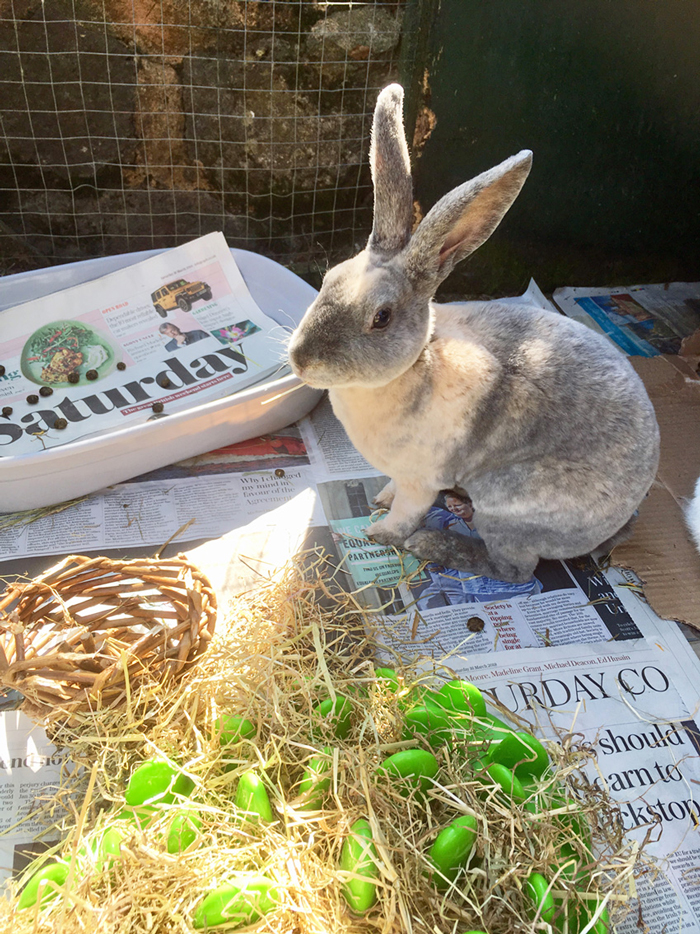
When rabbits are presented for a health check with either the vet or the nurse for a specific problem or illness, it is important we examine the rabbit holistically and take into consideration every part of the rabbit – not just the condition it is presented for. This should be carried out as we would for a cat or dog, taking into consideration the species-specific anatomical and physiological differences (Panel 1).
Eyes and tear ducts should be clear, with no discharge or clouding. Ears should be clean, with no signs of infection or crusting due to mites commonly affecting the pinna and the external ear canal, as this leads to pain and secondary infection if not treated promptly. Teeth should be of equal length, with no spurs. The teeth can be easily examined using an otoscope.
Auscultation of the abdomen should be performed, checking for a healthy digestive tract borborygmus. Pododermatitis can be common in rabbits, and if the hock sores are not treated, it can become infected, leading to further pain and discomfort.
Coat and skin should be clean, with no signs of alopecia or scaling often secondary to mite infestation in stressed rabbits. The perineal area should be clean, with no signs of urine scalding (skin inflammation) or fly strike – common in rabbits, especially during the hotter months. It is also important for owners to check their rabbits daily for signs of urine scalding or soft caecotrophs that have not been consumed.
We also need to ensure rabbits are weighed at each visit to the surgery, so we can monitor weight gain or loss, as this can be a very important indicator of illness or dental disease. Many veterinary clinics now offer rabbit weight clinics.
It is important we also body condition score them, just as we would cats and dogs, because of the variation of breeds and cross-breed rabbits – each one needs to be assessed individually.
All these issues could be contributing factors of poor husbandry or lack of knowledge in caring for the species. By notifying these problems, it may help us educate owners on better or alternative care (Figures 5 and 6).
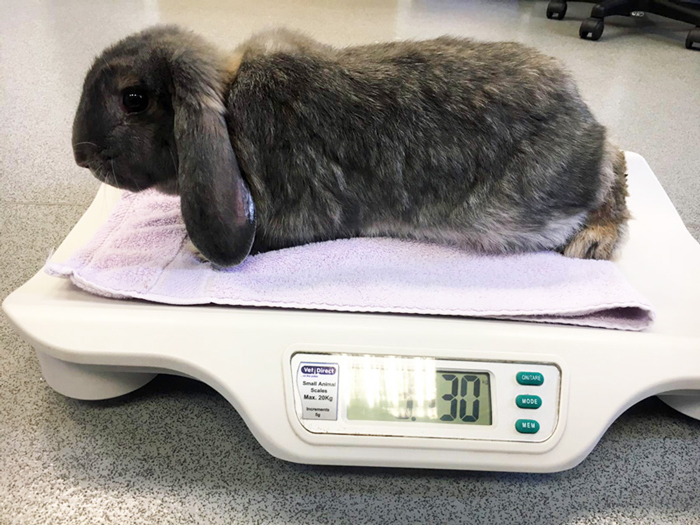
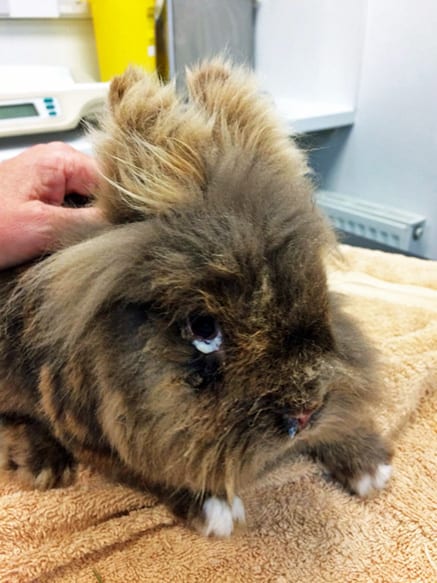
A survey carried out by PDSA showed almost 49% of rabbits had not been vaccinated with a primary course, equating to 490,000 unvaccinated rabbits in the UK (PDSA, 2018).
This is an area where we definitely need to provide extra information to owners when the rabbits are registered at the practice. This information can be given not only during health checks, but also via websites, leaflets and noticeboards.
Some practices also include rabbits in their healthy pet schemes, allowing clients to spread the cost of health care on a monthly basis. Reminders can be sent to clients either via text, email or post to help keep up with owner compliance.
Two main diseases can be vaccinated against – myxomatosis, and both strains of rabbit viral haemorrhagic disease (RVHD) – RVHD-1 and RVHD-2. While RVHD-1 has been around for a while, RVHD-2 has been identified in the UK since 2013. It is, therefore, important to inform owners that both strains need to be covered alongside the myxomatosis. The vaccine protocols shown in Table 1 can be used. It is advised to leave a gap of at least two weeks between vaccines.
| Table 1. Vaccine protocols | |||
|---|---|---|---|
| Vaccine brand | Age first dose can be given | Onset of immunity | Repeat dose |
| Eravac (rabbit viral haemorrhagic disease [RVHD]-2). Only product licensed in pet rabbits for RVHD-2 | 30 days old | 7 days | Every 9 months |
| Filavac VHD K C+V (RVHD-1 and RVHD-2) | 10 weeks old | 7 days | Every 12 months |
| Nobivac Myxo-RHD (myxomatosis, RVHD-1) | 5 weeks old | 3 weeks | Every 12 months |
| Adapted from NOAH Compendium. | |||
Although research has shown RVHD-2 is endemic throughout the UK, and in the past two years the only PCR-positive tests results are RVHD-2, there is also a new strain in Australia and New Zealand referred to as K5, although it looks as though the Nobivac Myxo-RHD-1 vaccine will cover this.
These days, neutering is a standard procedure in most practices. Protocols can be discussed during consultations to help reassure owners and help them understand what is involved.
Small to medium-breed rabbits can become sexually active from four to six months, while giant breeds will become sexually mature at six to nine months of age. Neutering can be carried out anytime onwards depending on practice policy.
As they are social animals, rabbits need to be able to live together amicably without fighting or producing unwanted litters. Some are naturally dominant, and neutering may help this. However, they should still be provided with a big enough space to include separate resources to prevent conflict, such as multiple hiding places, food bowls, hay racks and sheltered areas.
Health benefits of neutering can also be discussed with clients, including uterine disease in does, pseudopregnancy, mammary tumours, aggressive behaviour, urine spraying and testicular tumours in bucks.
Practice health plan schemes are now available for rabbit owners at some veterinary practices these days. This allows the clients to pay in monthly instalments and helps distribute the cost for the vaccinations, six-monthly health checks and parasite control. Some plans may also offer discounts and promotions on diet and neutering.
These schemes not only help the animal receiving the necessary preventive treatment, but also create a bond between the rabbit owner and the veterinary team.
Nowadays, rabbit medicine is constantly improving, allowing us to use a range of diagnostic techniques, and medical and surgical treatments, as never before. Insuring our rabbit patients helps cover the costs of unexpected large vet bills, and allows for further investigations and treatments without financial worries for the owner. Insurance for rabbits is becoming readily available from several companies; however, they are not as popular as those for cats and dogs.
A survey carried out by PDSA showed only 13% of UK rabbits are insured (PDSA, 2018). Although this is a very small proportion, it is a dramatic increase compared to 10 years ago when rabbit insurances barely existed. Insurance should be discussed with the owner alongside neutering and vaccinations, and advocated using care sheets and media.
Although our society has been keeping rabbits as pets for hundreds of years, the views on their lifestyle, companionship and husbandry has dramatically changed. Clients have become much more bonded to them, more observant to signs of illness and compliant to preventive care.
This is why it is so important to be offering all the advice and up-to-date information we can during our consultations and in the literature we provide. In time, this will hopefully contribute to more rabbits living healthy and happy lives for many years to come.